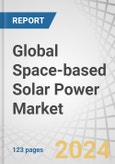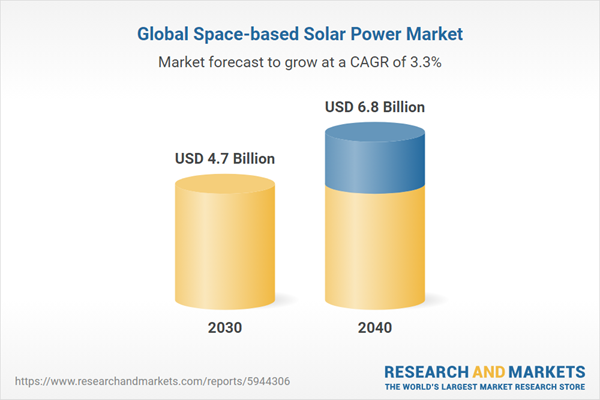The Space-based Solar Power market is estimated to grow from USD 6.8 billion by 2040, from USD 4.7 billion in 2030, at a CAGR of 3.3% from 2030 to 2040. The increasing demand for green energy is a primary driver for Space-based Solar Power as it offers a continuous and abundant source of clean energy, untethered by terrestrial limitations. Space-based Solar Power’s potential to meet this demand sustainably, without greenhouse gas emissions, positions it as a vital contributor to the global transition towards renewable energy solutions.
Strategic partnerships between European Space Agencies (ESA), Airbus and EMROD will facilitate collaborative efforts to advance Space-based Solar Power technologies and infrastructure. Joint initiatives often lead to the development of innovative Space-based Solar Power solutions tailored to specific models.
Laser Beam Power Transmission segment by beam type is expected to hold the second highest market share in 2030
Based on Beam Type, the Space-based Solar Power market is categorized into laser beam power transmission and microwave power transmission. The laser beam power transmission segment having second highest share of 10%. The laser beam power transmission, beam type segment in the Space-based Solar Power market is driven by advancements in laser technology, enabling efficient and focused energy transmission from space to Earth based receivers. Improved laser efficiency, beam control systems, and safety measures contribute to the growth of this segment, enhancing the feasibility and commercial viability of laser-based Space-based Solar Power systems. Overall, both laser beam power transmission and microwave power transmission segments are crucial for the sustainable growth of the Space-based Solar Power market.Commercial segment by end users is estimated to hold the second highest market share in 2030
Based on End Users, the market is further divided into Government and Defense and Commercial end users. The need for reliable and resilient energy sources, particularly for remote operations and off-grid facilities, will drive commercial interest in Space-based Solar Power, which offers uninterrupted power generation capabilities. Partnerships and collaborations between commercial enterprises and space industry stakeholders will facilitate the development and deployment of Space-based Solar Power systems adapted to commercial needs, driving market growth and adoption.Europe is expected to hold the second highest market share in 2030
The European Union's ambitious renewable energy targets and commitment to decarbonization under the European Green Deal will incentivize investment in innovative clean energy solutions like Space-based Solar Power. In addition, Europe's established space industry, advanced technological expertise, and strong research and development capabilities position it as a key player in Space-based Solar Power innovation and deployment. Also, the region's dense population centers and limited land availability make space-based solutions increasingly attractive for meeting energy needs sustainably. supportive regulatory frameworks and incentives at both national and EU levels will provide further impetus for the development and commercialization of Space-based Solar Power projects in the region.Strategic partnerships between European Space Agencies (ESA), Airbus and EMROD will facilitate collaborative efforts to advance Space-based Solar Power technologies and infrastructure. Joint initiatives often lead to the development of innovative Space-based Solar Power solutions tailored to specific models.
The break-up of the profile of primary participants in the Space-based Solar Power market:
- By Company Type: Tier 1 - 49%, Tier 2 - 37%, and Tier 3 - 14%
- By Designation: C Level - 55%, Director Level - 27%, Others - 18%
- By Region: North America - 32%, Europe - 32%, Asia-Pacific - 16%, Middle East - 10%, Latin America - 7%, Africa - 3%
Research Coverage
- In terms of applications, the Space-based Solar Power market is divided into terrestrial and space applications.
- The beam type segment of the Space-based Solar Power market is divided into laser beam power transmission and microwave power transmission.
- The end users-based segmentation includes government and defense, and commercial.
- This report segments the Space-based Solar Power market across three key regions: North America, Europe, Asia-Pacific. The report's scope includes in-depth information on significant factors, such as drivers, restraints, challenges, and opportunities that influence the growth of the Space-based Solar Power market.
- A comprehensive analysis of major industry players has been conducted to provide insights into their business profiles, solutions, and services. This analysis also covers key aspects like agreements, collaborations, new product launches, contracts, expansions, acquisitions, and partnerships associated with the Space-based Solar Power market.
Reasons to buy this report
This report serves as a valuable resource for market leaders and newcomers in the Space-based Solar Power market, offering data that closely approximates revenue figures for both the overall market and its subsegments. It equips stakeholders with a comprehensive understanding of the competitive landscape, facilitating informed decisions to enhance their market positioning and formulating effective go-to-market strategies for Simulation. The report imparts valuable insights into the market dynamics, offering information on crucial factors such as drivers, restraints, challenges, and opportunities, enabling stakeholders to gauge the market's pulse.The report provides insights on the following pointers:
- Analysis of the key driver (Increasing global requirement for energy consumption, technological evolution of green energy generation), restraint (high initial investment cost, space debris and maintenance concerns, political and regulatory landscape) opportunities (a country’s strategic independence, government initiatives for green energy ecosystem) and challenges (technological challenges involved in power transfer, competition with other renewable sources, expensive geo/leo launch cost, space based assembly) there are several factors that could contribute to an increase in the Space-based Solar Power market.
- Market Penetration: Comprehensive information on Space-based Solar Power systems offered by the top players in the market
- Product Development/Innovation: Detailed insights on upcoming technologies, research & development activities, and new product & service launches in the Space-based Solar Power market
- Market Development: Comprehensive information about lucrative markets - the report analyses the Space-based Solar Power market across varied regions.
- Market Diversification: Exhaustive information about new products & services, untapped geographies, recent developments, and investments in the Space-based Solar Power market
- Competitive Assessment: In-depth assessment of market shares, growth strategies, and service offerings of leading players in the Space-based Solar Power market
Table of Contents
1 Introduction
2 Research Methodology
3 Executive Summary
4 Premium Insights
5 Market Overview
6 Industry Trends
7 Space-based Solar Power Market, by Beam Type
8 Space-based Solar Power Market, by Application
9 Space-based Solar Power Market, by End-user
10 Space-based Solar Power Market, by Region
11 Competitive Landscape
12 Company Profiles
13 Appendix
Companies Mentioned
- Airbus
- Northrop Grumman
- Ohb SE
- Thales Alenia Space
- Boeing
- Emrod
- Airborne
- Spacetech GmbH
- Virtus Solis
- Azur Space Solar Power GmbH
- Cesi S.P.A.
- Celestia Energy
- Sirin Orbital Systems AG
- Overview Energy
- Space Solar
- Solar Space Technologies
- Metasat UK
- Photonicity Pte. Ltd.
- Satellite Applications Catapult Limited
- Solaren Corporation
- Powerlight Technologies
- Fralock LLC
Table Information
| Report Attribute | Details |
|---|---|
| No. of Pages | 123 |
| Published | February 2024 |
| Forecast Period | 2030 - 2040 |
| Estimated Market Value ( USD | $ 4.7 Billion |
| Forecasted Market Value ( USD | $ 6.8 Billion |
| Compound Annual Growth Rate | 3.3% |
| Regions Covered | Global |
| No. of Companies Mentioned | 22 |









